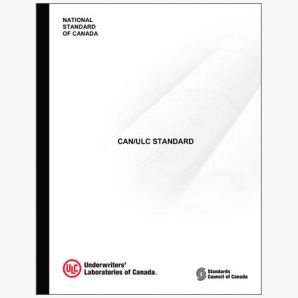TOLL FREE · 1-888-361-0003 Our Customer Support is ready to help!

Formats Available:
Softcover,
Online
Product Overview
CAN/ULC-S712.1:2017 Standard for Thermal Insulation - Light Density, Open Cell Spray Applied Semi- Rigid Polyurethane Foam - Material Specification Second Edition
ULC CAN/ULC-S712.1:2017 Standard for Thermal Insulation - Light Density, Open Cell Spray Applied Semi- Rigid Polyurethane Foam - Material Specification Second Edition
Total
As low as
$0.00
More About This Product
Description
"This Standard specifies the physical property requirements and test methods to determine the material properties for light density, open cell spray applied semi-rigid polyurethane foam, used as a thermal insulation for building applications, whether applied on a building site or in a prefabrication (manufacturing) facility.
The spray polyurethane foam system installer site manufactures the light density, open cell spray applied semi-rigid polyurethane foam material identified by this Standard. The spray polyurethane foam system manufacturer produces a liquid “resin” component and supplies the corresponding polymeric isocyanate which, when mixed together on a fixed ratio basis, produce the material which results in the physical properties listed in this Standard. The Standard CAN/ULC-S712.2 includes mandatory requirements for the installation of the material as well as qualification of contractors and the qualification of installers and forms an integral part of the manufacturing process for the finished material.
The test methods listed in this Standard are used to determine the values for the physical properties. These physical property values are intended for use in specifications, material evaluations and quality control. They are not intended to predict end-use material performance.
This standard applies to material where the continuous service temperature of the substrate is within the range of -60 to +70 °C.
The testing and evaluation of a material against this Standard may require the use of materials and/or equipment that could be hazardous. This Standard does not purport to address all the safety aspects associated with its use. Anyone using this Standard has the responsibility to consult the appropriate authorities and to establish appropriate health and safety practices in conjunction with any existing applicable regulatory requirements prior to its use."
"This Standard specifies the physical property requirements and test methods to determine the material properties for light density, open cell spray applied semi-rigid polyurethane foam, used as a thermal insulation for building applications, whether applied on a building site or in a prefabrication (manufacturing) facility.
The spray polyurethane foam system installer site manufactures the light density, open cell spray applied semi-rigid polyurethane foam material identified by this Standard. The spray polyurethane foam system manufacturer produces a liquid “resin” component and supplies the corresponding polymeric isocyanate which, when mixed together on a fixed ratio basis, produce the material which results in the physical properties listed in this Standard. The Standard CAN/ULC-S712.2 includes mandatory requirements for the installation of the material as well as qualification of contractors and the qualification of installers and forms an integral part of the manufacturing process for the finished material.
The test methods listed in this Standard are used to determine the values for the physical properties. These physical property values are intended for use in specifications, material evaluations and quality control. They are not intended to predict end-use material performance.
This standard applies to material where the continuous service temperature of the substrate is within the range of -60 to +70 °C.
The testing and evaluation of a material against this Standard may require the use of materials and/or equipment that could be hazardous. This Standard does not purport to address all the safety aspects associated with its use. Anyone using this Standard has the responsibility to consult the appropriate authorities and to establish appropriate health and safety practices in conjunction with any existing applicable regulatory requirements prior to its use."
